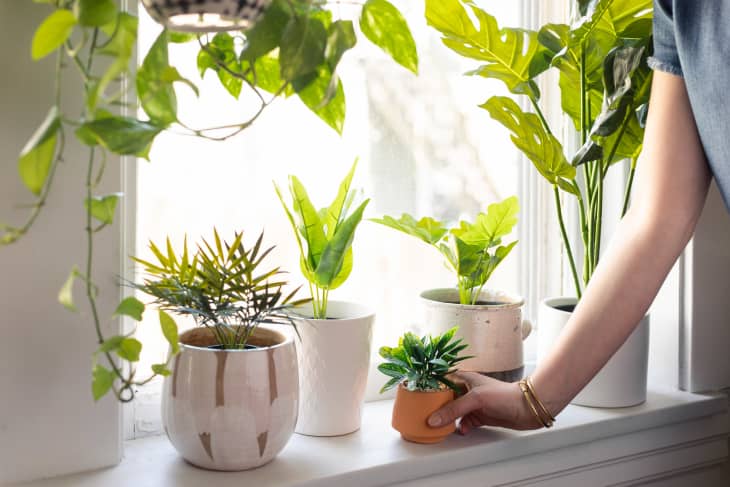7 Windowsill Plants That Bring Big Style to Small Spaces

Windowsills are seriously prime real estate in your home when it comes to plants. Not only are they bright—they’re also a perfect balance of out of the way (so plants are less likely to be jostled) and within sight (so they’re unlikely to be forgotten). And the guaranteed light—whether direct or indirect—makes them forgiving places to start for new plant parents, to boot. Need some inspiration to get going? These seven houseplants are a few of my favorite options to choose from when contemplating windowsill decor.
Philodendron Birkin
If you walk into my office, you’ll see one of these plants perched right on the windowsill, basking in the northern light exposure. As Birkins get larger you’ll have to relocate them, but if you have a plant that will sit on your windowsill, it will flourish.
Treat this plant with basic philodendron care. It will need bright, indirect light because the variegation on the leaves indicates that the plant will need more light than other philodendrons in order to perform photosynthesis.
Windowsills with direct light won’t work for this guy. You’ll end up scorching its leaves. The right amount of light will help the plant develop more defined variegation on its leaves. Water when the soil dries an inch from the surface.
Can’t get your hands on a Birkin? Any smaller-sized philodendron will perform well on a sill. Keep in mind that philodendrons are considered toxic to both dogs and cats.
Echeverias
Yes, echeveria plants are still very popular. These plants are known to be relatively easy to care for (as long as you don’t overwater them) and are small enough to balance delicately on even the smallest windowsill.
Echeverias need bright light and minimal watering, so essentially you can set it down and forget about it until it’s time to give your plant a little water. Do not overwater or your plant will rot—especially in a pot or terrarium with no drainage. Let the soil dry out completely in between watering to ensure you’re in the clear.
Keep an eye out for sunburned leaves if your plant is getting southern or eastern exposure to the sun.
Consider moving your succulents from the windowsill when outside temps drop below freezing. Most succulents will freeze on windowsills in the wintertime, even if you have double-paned windows.
Pilea Peperomioides
While it is originally from the southwestern Yunnan province of China, the Pilea peperomioides has made appearances all over the globe. The story goes that back in the 1940s, a missionary from Norway took some cuttings home with him from China and then gifted to some folks. This started the global spread of the plant as well as the nickname “friendship plant.”
Unless you have an extremely mature plant, P. peperomioides is compact, which makes it perfect for windowsill living. It doesn’t hurt that this plant loves bright, indirect light. Be careful with south-facing windows—direct, hot sun will scorch the leaves. As long as the temperatures remain above freezing, this plant will thrive for you.
Warning: Don’t overwater this plant. Treat it almost like a succulent. Plant it in well-draining soil and water it only when the soil is completely dry.
Venus Flytraps
If you’re looking for a funkier plant for your office windowsill, try out a Venus flytrap. These bizarre, compact plants have been a longtime staple of many plant collectors. The leaves of the Venus flytrap have little “trigger” hairs on them that spring the traps. When the hairs are touched, the leaves clamp shut, catching the prey. The plant then secretes digestive fluids that dissolve the prey, which is how the plant gets its nutrients.
Venus flytraps love bright, indirect light and lots of humidity. Put one in a shallow tray of water in the window and let it go. If you don’t have a lot of random bugs flying around your house, you’ll need to feed your plant a couple of times per month; you can use flies, dried mealybugs, or flakes of fish food.
African Violets
I’ve found that my violets prefer to be bottom-watered, so I pour water right into the collection tray for the plant to suck up into the soil. They won’t like water or any kind of moisture on their leaves or flowers. Let the soil dry out a couple of inches deep before watering again.
Rosemary
A rosemary plant is perfect for your windowsill because, when grown indoors, it needs tons of bright light. In fact, it’s rare it can be grown indoors without solid exposure to a bright window.
Plant rosemary in a terracotta pot with a drainage tray to prevent overwatering. It has to be planted in a container that has drainage—it will not grow in a pot that holds water. Rosemary likes to have dry “feet” (or roots), but loves humidity on its leaves. It’s what folks call an “upside down” plant.
Water the plant only when the soil is dry, but mist it multiple times a week. That regular misting could make all the difference to your rosemary surviving indoors.
Aeoniums
The aeonium is a gorgeous plant. The leaves grow in the shape of a flower on the end of the branches. Aeoniums are sought after for their rosette shape and the ease with which they grow, which puts them right into our windowsill category.
Aeoniums need bright, direct light. Water only when the soil dries out completely, and remember that if you have a larger plant, it will drink a larger quantity of water. Be on the lookout for signs of spider mites and